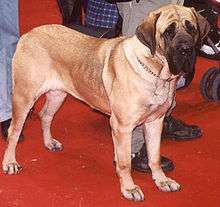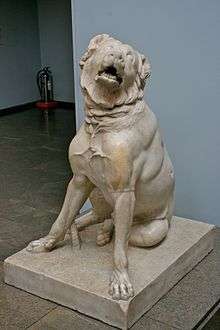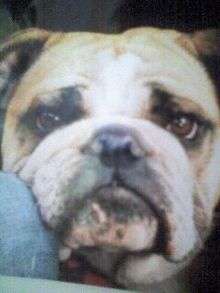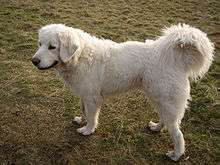Molosser

Molosser is a category of solidly-built, large dog breeds that all descend from the same common ancestor. The name derives from Molossia,[1] an area of ancient Epirus,[2] where the large shepherd dog was known as a Molossus.[3]
Molossers typically have heavy bones, pendant ears, a relatively short and well-muscled neck, and a short broad muzzle.
Origins
Nineteenth-century army veterinarian and entomologist Jean Pierre Mégnin theorized there were four basic canine races based on his observation of their different skull structures: Lupoides (Spitz), Braccoides (scenthounds), Graioides (sighthounds), and Molossoides (mountain dogs, Mastiff breeds and even Pugs).[4] Although study of the canine genome is causing the revision of phenotype-based taxonomies such as Mégnin's, the four categories are still used in some traditional contexts.
Function
Molossers are used for a variety jobs that require strength and size. Some molosser types are used for search and rescue dogs, such as the Newfoundland and the Saint Bernard. Some are used as guard dogs to protect property from intruders. Livestock guardian dogs live alongside livestock and offer protection against large predators and poachers. The Greater Swiss Mountain Dog has been used as a cart dog.
Development
The oldest known record of a Molosser-type dog is found in its name, which is the namesake of the people who first used these dogs: Molosser is an eponym of King Molossus, the grandchild of the mighty Achilles famed in the Trojan War, who ruled the ancient tribe of Molossians in Epirus. Since the ancient region of Epirus has historically been claimed by such modern countries as Greece and Albania, there is some dispute over the molosser's exact origin. The people of Epirus were a seafaring people and these dogs sailed with their masters to Asia, where selective breeding gave them multiple phenotypes that were better suited to their new climates and roles.
As these ancient Molosser dogs were exported to West Asia, Central Asia, South Asia, and North Africa, they soon adapted to their surroundings and interbred with local dogs resulting in offspring with shorter, differently colored coats but retained more anatomical morphology traits like height and massive heads with short muzzles.
The dogs were considered valuable in Babylon, and are mentioned in cuneiform in the 4th century BC. A large Mastiff-like dog is shown on the ancient terra cotta by Birs Nimrud. The dog is 90 centimetres (35 in) tall at the withers, has a stocky head and powerful hind quarters. The dogs were used for hunting in ancient Assyria. Archeological digs of the Ashurbanipal palace (7th century BC) revealed pictures of dogs felling wild horses and donkeys. Assyrian Mastiffs were also used for military purposes and for protection.

The ancient Mastiffs would later be imported from Assyria and Babylon to Egypt and Asia Minor. Xerxes I of Persia led predatory wars to enlarge the borders of his empire, taking with him large war dogs in his army. Mastiffs were used to fight in the Roman amphitheater against lions and may have been used in lion hunting. They are the root of many shepherd and mountain dog breeds.
The Alans kept Mastiff-like dogs taken from Eastern Europe which acted as retrievers, guard dogs, and fighting dogs. The name associated with these dogs is Alaunt, or in Spanish, Alano. The Mastiffs were used in unison with sighthounds to hunt wisent, aurochs, and bear. Groups of Alanian tribes came to Europe during the Migration Period, fighting on the territory of modern Portugal, Spain, France, Italy, and North Africa, taking with them their dogs. The Alanian Mastiff then spread to the British Isles. The Mastiffs of the Alps, the Alpine Mastiff, was a progenitor of the St. Bernard and contributed to the modern English Mastiff.
The Newfoundland dog is the only Canadian Molosser-type dog breed. Portuguese fishermen have fished off the shores of Newfoundland for centuries, and the Newfoundland breed was the result of Portuguese Mastiffs breeding with St. John's water dog.

The Bulldog breeds split from the Molossers in Europe and spread to the New World with colonization. Though smaller, Bulldogs are still considered to be Molosser breeds.
In contemporary culture they are also known as Mastín (Spanish), Dogue or Dogo (Romance languages), and Dogge (Germanic).
Mastiff confusion
Breeds such as the Fila Brasileiro, Pyrenean Mastiff (Mastín del Pirineo), Spanish Mastiff, Tibetan Mastiff, Cane Corso, and many others that fall into the larger category of "molossers" are of Mastiff-type, but are not true Mastiffs. The term "Mastiff", when used alone, refers specifically to the "English Mastiff" breed. Other true Mastiff breeds include the Dogue de Bordeaux, Neapolitan Mastiff, and Bullmastiff. Each is a separate and distinct breed. The Boxer breed is also included, as it is a creation from other molossers including the Old English Bulldog.
Recognized breeds
This is a list of all breeds that fit into the Molosser category of dogs.[5]
1. Argentina
2. Brazil

3. Canada
4. China
5. Denmark
6. France
7. Germany
8. Germany/Switzerland
9. Great Britain

10. Hungary
11. Italy
- Lakota Mastino
- Neapolitan Mastiff
- Cane Corso Italiano
12. Japan
13. Morocco
11. Pakistan
- Bully Kutta
- Gull Terr
14. Portugal
15. Russia
16. Serbia
17. Slovenia
18. Spain
- Alano Español
- Ca de Bou
- Dogo Canario (Provisionally Accepted)
- Spanish Mastiff
- Pyrenean Mastiff
19. Switzerland
- Appenzeller Mountain Dog
- Bernese Mountain Dog
- Entlebucher Mountain Dog
- Greater Swiss Mountain Dog
- Saint Bernard
20. Tibet
21. Turkey
22. United States of America
23. Uruguay
Unrecognised breeds
1. Afghanistan
2. Armenia
3. Azerbaijan
- Azerbaijani shepherd dog
4. Brazil
- Bulldog Campeiro
5. Canada
6. Greece
7. Guatemala
8. Italy
- Dogo Sardesco
- Cane di mannara
9. India
10. Iran
- Persian Mastiff
- Ghadrejani dog
- Saga mazandrani dog
- Sage ashayeri dog
- Shirak sheepdog
- Kurdish shepherd dog
11. Korea
- Korean Mastiff
12. Kurdistan and Iraq
- Kurdish shepherd dog (pshdar and Iraq)
13. Mongolia
- Mongolian banhar
14. Nepal
15. Poland
16. Russia
- Buryat-Mongolian Wolfhound
17. South Africa
18. Tibet
19. United Kingdom
20. United States of America
- American Mastiff
- Gran Mastín de Borínquen
- Olde English Bulldogge
Smaller Molosser breeds
1. China
2. England
3. United States of America
- Boston Terrier
- Olde Boston Bulldogge
See also
Notes
- ↑ According to AKC the Boerbel or South African Mastiff is the same as the English Mastiff, being introduced to South Africa in the 17th century.
References
- ↑ Dogue De Bordeaux: A Comprehensive Owner's Guide by Joseph Janish, ISBN 1-59378-215-2,2003, p. 10, "The Dogue de Bordeaux falls into a group of dogs classified as molossers, descendants of the Molossus, a dog that lived around the time of 700 BC."
- ↑ The Mini-Atlas of Dog Breeds by Andrew De Prisco,ISBN 0-86622-091-7,1990,page 136,"... Mastiff prototypes , such as the Molossus of Epirus and Babylonian Mastiff, were used as flock guards against wolves and other predators. ..."
- ↑ The molossid bats are named after this breed of dog: The Mammals of the Southern African Sub-region by J. D. Skinner, ISBN 0-521-84418-5,2006, p. 277, "The name of the [free-tailed bats] family is derived from the Greek molossus, a kind of dog used by Greek shepherds in ancient times."
- ↑ Mastiffs, The Big Game Hunters, by David Hancock. pg. 24, 'Classification of canine types', 2000. ISBN 0-9527801-2-7
- ↑ "FCI Breeds Nomenclature". Fci.be. Retrieved 2016-06-19.
External links
| Wikimedia Commons has media related to Molosser. |
- Gallery of Molosser breeds
- Gallery of Molosser breeds
- Greek Molosser breeds
- Greek Molosser Cynopedia
- List of Molosser and Rare Breeds


